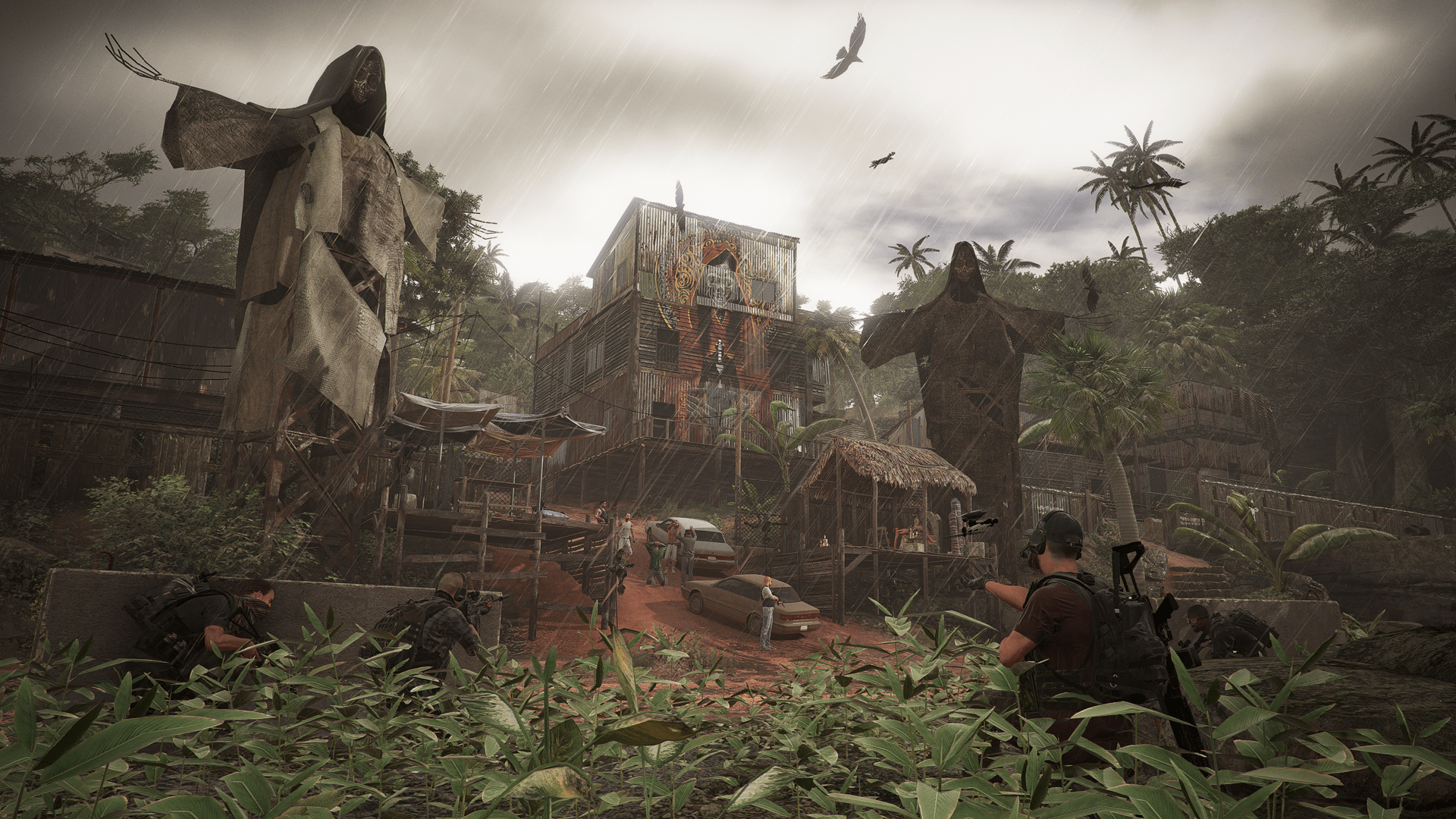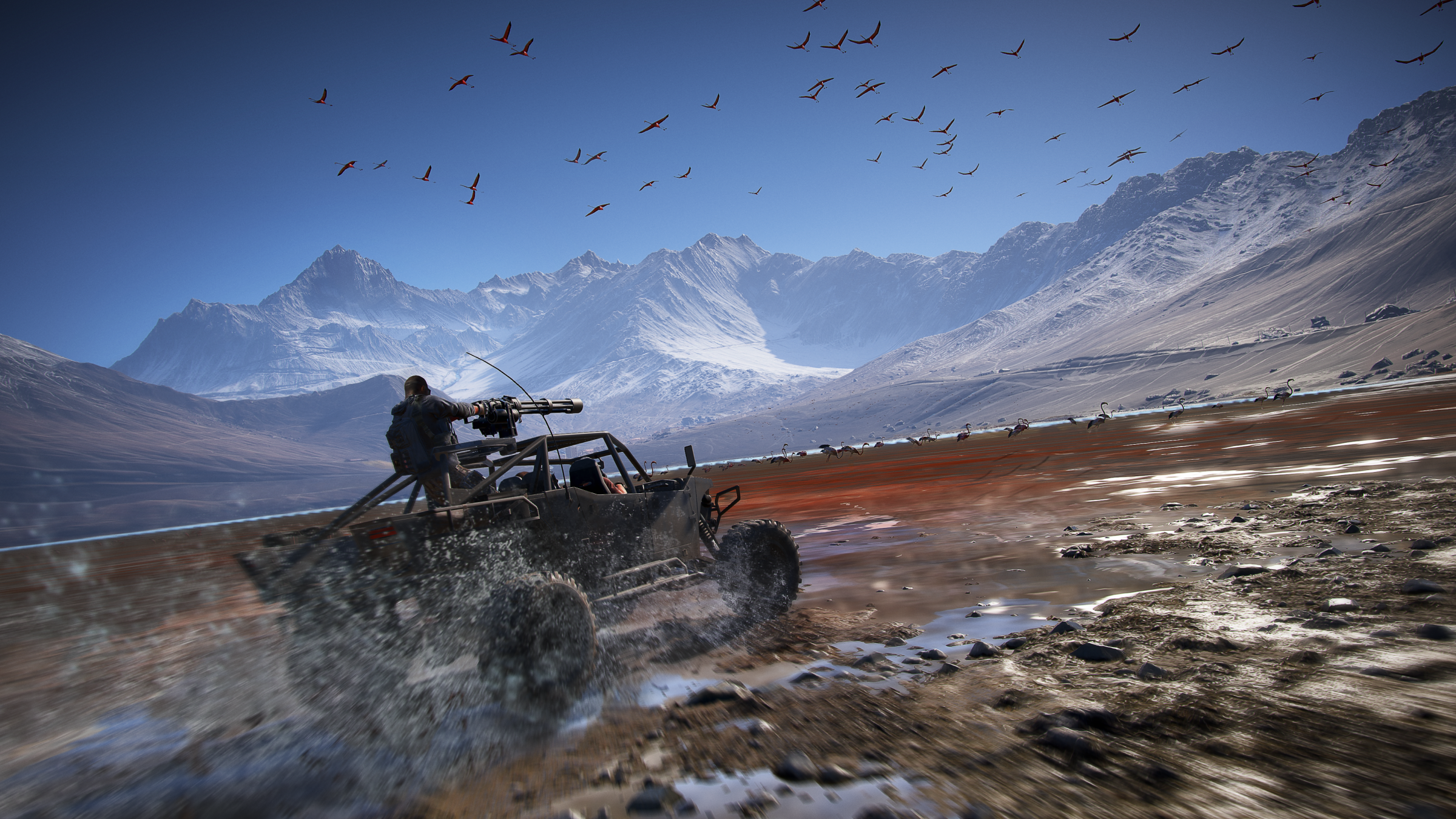To play a Ubisoft game these days is to participate in a grand experiment. You may not realize this, but it’s true. Look at any of the company’s games, and you’ll see that the French multinational publisher of franchises like Assassin’s Creed, Watch Dogs and Far Cry is obsessed with repurposing its ideas, like an artisan trying to forge a novel new musical instrument from the fragments of existing ones.
Thus in the cartel-subjugated Bolivian hinterlands of Ghost Recon Wildlands, the company’s biggest free roaming adventure yet (out March 7 for PC, PlayStation 4 and Xbox One), helping the country’s insurgents lets players summon them later to do battle—a feature in Far Cry 4. To surveil and mark enemy targets, players can pilot a backpack drone—something they could do in last year’s Watch Dogs 2. Playing cooperatively with other online friends is a button tap away, a “seamless multiplayer” feature Ubisoft honed in The Crew. And players can reconnoiter the map for optional sorties or collectibles to flesh out the game’s backstory and unlock new abilities. That’s something they’ve been doing in Ubisoft games since the original Assassin’s Creed shook the industry in 2007.
This jumbling of old and new feels like probing toward some kind of open world experience to rule them all. But the last few tries have been mediocre. Assassin’s Creed Unity‘s gorgeous Parisian vistas were wasted on fiddly controls and lackluster sneak-play. The Crew was glitchy at launch, and offended many with its exorbitant microtransactions. And while Watch Dogs 2‘s story, characters and Bay Area setting were, in that order, smart, simpatico and gorgeous, its computer hack-driven skirmishes fell apart once players unlocked a few exploitive powers.

Not so Wildlands, whose designers seem to have figured out, finally, that equipoise in a game that offers this much independence entails fashioning enemies that resist exploitation and bite back hard. Players can still travel anywhere their gaze falls at whatever pace or in whichever order the spirit moves them. (The game’s fictitious Bolivian vales and summits are breathtaking, and rubbernecking costs nothing.) But if they want to wrestle with the central challenge—deconstructing a regional cartel, one tenacious sub-boss at a time—they’ll have to contend with battalions of thrillingly brutal bad guys.
It’s as if Ubisoft noticed everything that bugged me about Watch Dogs 2, then rolled the fixes into a darker, black ops jogging tour of remote South American woodlands, lagoons and salt flats. Throughout this expanse Wildlands‘ designers deposit thickets of cartel soldiers you can approach any way you like, land, sea or air. Each encounter becomes a delightful mini-playground bulwarked by thugs whose behavior varies depending on the time of day, and who you have to sneak past or obliterate to complete objectives like assassinating local bosses, rescuing rebel leaders, or gathering intel for followup ops.
The game transpires a few years from the present day, imagining, as in some George W. Bush-era fantasy, that a clandestine quartet of military elites were all it might take to topple a narco-state. Like a Tom Clancy yarn, the story is likewise littered with covert jargon and military niceties. (Note that author Tom Clancy never wrote a Ghost Recon novel; the “Tom Clancy’s” appellation just signals the series’ spiritual fraternity with the Splinter Cell and Rainbow Six games.) As in Ubisoft’s The Division, weapons are numerous and adjustable, sporting metrics like “damage,” “rate of fire” and “noise reduction” that can be fine-tuned with add-ons in areas like “optics,” “rails” and “underbarrels.” Anyone with a ballistic fetish should find plenty to like, from classic bolt action sniper rifles to 12-gauge Kalashnikov-inspired shotguns.

Players begin near the center of a map that’s divvied into cartel-controlled regions, wending their way outward to explore increasingly treacherous zones that check all the classic biome boxes. Here’s the part where you’re in a jungle. There’s the part where you tromp through a desert. Go climb a mountain range to get your ice and snow fix. It’s like an exotic virtual brochure for all the places you wish you could be.
Bossing the computer around is simple and effective. When playing solo, players can direct squad members by pulling up a half-wheel with commands like “go to,” “fire” or “regroup.” Another half-wheel that’s unlocked piecemeal lets players ask rebels to deliver vehicles, cause diversions or lob mortar shells at targets. Wildlands also mercifully manages to keep its skill tree uncrowded, offering a handful of upgradeable abilities in five categories (weapon, drone, item, physical, squad). These subdivide instead into multiple unlocks that might, for instance, offer better battery life to the drone, or provide better bullet resilience to squad-mates. It’s a wise distillation that lets players focus on perfecting the tactical nuances of a few things, instead of juggling dozens.
A few parting complaints, none major, but some that seem oddly overlooked. I can drive vehicles and fly planes no problem, but still can’t figure out helicopters, which fly nothing like real helicopters do (or as the controls imply they should). For all the enemy’s combat chops, it needs better self-preservation instincts: more than once, a bad guy went splat stepping in front of an oncoming vehicle while chasing me down. And—I admit this last one is weird, but see for yourself—the clouds in Wildlands‘ skies are broken and terrifying, racing along at freakish time lapse speeds and spoiling otherwise picturesque panoramas.

But what most worried me—because it’s a problem in so many other Ubisoft games—was that the A.I. would eventually bore me. (Trying different things over and over and getting the same results isn’t the definition of insanity, but it can leave you stultified.)
Thus far the opposite is true of Wildlands. Just when you think you’ve figured out how to catch the game in a loop, it throws something new at you. Like spotlights (with switchable power junctions) that make you more visible at night. Or compounds that jam your drone’s signal, rendering it useless (and you tactically blind). Or agitated enemies who become relentless hunters as well as wicked smart shots at sniper distances. Or the withering assaults from mortars, helicopters and surface-to-air missiles that will send even the ablest players scrambling to retreat.
Watching all this unfold feels like listening to a jazz musician tee up changes for fellow players to jam over. Slight variations ripple and become riveting permutations. We’ve seen and to a certain extent done much of this in games like Far Cry 4 and Watch Dogs 2. But never on this scale, or as deftly balanced.
4.5 out of 5. Buy Ghost Recon: Wildlands now: PC, PlayStation 4, Xbox One.
Reviewed on PlayStation 4 Pro
(Read TIME’s affiliate link policy.)
More Must-Reads From TIME
- The 100 Most Influential People of 2024
- Coco Gauff Is Playing for Herself Now
- Scenes From Pro-Palestinian Encampments Across U.S. Universities
- 6 Compliments That Land Every Time
- If You're Dating Right Now , You're Brave: Column
- The AI That Could Heal a Divided Internet
- Fallout Is a Brilliant Model for the Future of Video Game Adaptations
- Want Weekly Recs on What to Watch, Read, and More? Sign Up for Worth Your Time
Write to Matt Peckham at matt.peckham@time.com